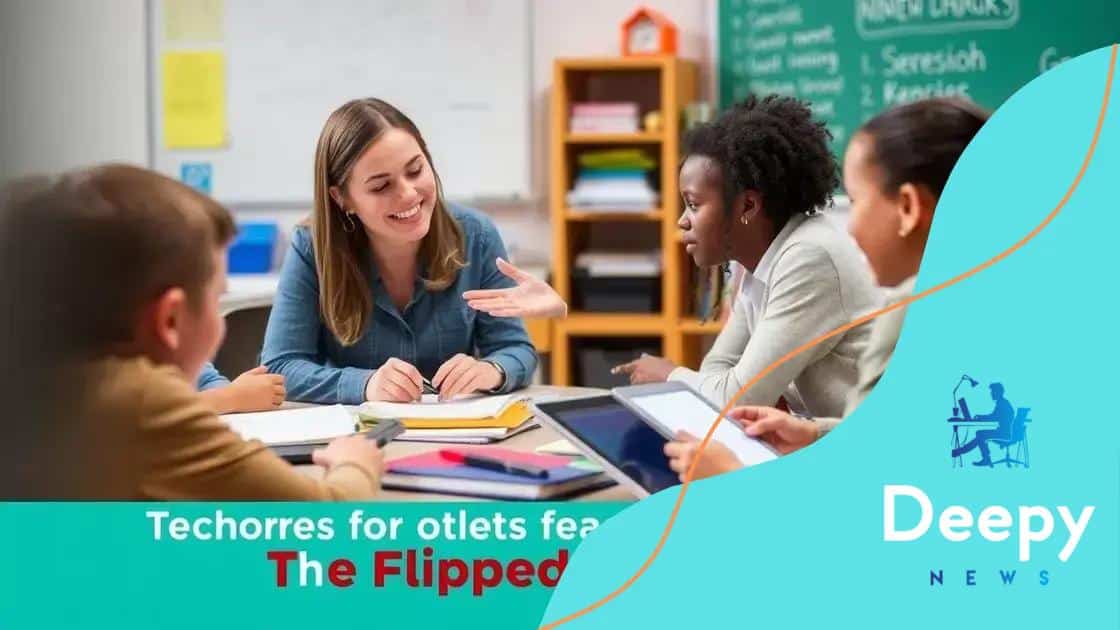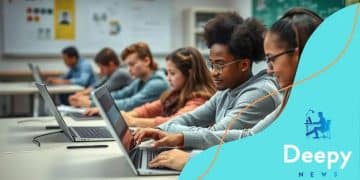How the flipped classroom model is evolving in modern education

The “flipped classroom” model enhances student engagement and learning by allowing students to study content at home and participate in interactive activities during class.
How the flipped classroom model is evolving is reshaping educational practices across the globe. Have you ever wondered how this approach enhances learning experiences for students? Let’s dive in.
Understanding the flipped classroom concept
The flipped classroom concept is transforming the way students learn and interact with educational content. Instead of traditional teaching methods, where instructors deliver lectures during class, the flipped classroom allows students to learn at their own pace outside of class time. This can be achieved by watching recorded lectures, reading materials, or engaging with interactive online content before coming to class.
Key Features of the Flipped Classroom
There are several key features that define the flipped classroom model. Here are some important aspects:
- Pre-class preparation: Students engage with the content at home, providing a foundation for discussion and application during class.
- Active learning: Classroom time is used for collaborative activities, discussions, and hands-on projects that reinforce the material.
- Teacher facilitation: Instead of lecturing, teachers guide students through problem-solving and apply concepts in real-world scenarios.
By shifting the focus from passive listening to active participation, the flipped classroom creates a vibrant learning environment. Students feel more empowered to take charge of their education, resulting in better retention of information and improved performance.
Engagement and Collaboration
Another essential element is increased engagement and collaboration among students. When class time is dedicated to discussion and teamwork, learners become more involved in their education. This new method fosters a community of learners who support each other and share knowledge.
The flipped classroom also encourages learners to ask questions and clarify doubts in real-time. This immediate feedback loop supports better understanding and allows teachers to adapt lessons based on student needs.
Benefits for Diverse Learning Styles
Finally, the design of the flipped classroom caters to various learning styles. Visual learners can benefit from video content, while auditory learners can engage with podcasts or discussions. Kinesthetic learners thrive in hands-on activities during class.
The flipped classroom concept is more than just a trend; it’s a revolutionary approach to education that promotes active learning and student ownership. By paving the way for innovative teaching practices, educators are setting students up for success in an ever-changing world of knowledge and skills.
Key benefits for students and teachers
Understanding the key benefits of the flipped classroom model is essential for both students and teachers. This approach changes the learning landscape by making education more interactive and personalized. Students gain insights and improve their skills while teachers can focus more on facilitating learning than delivering lectures.
Enhanced Student Engagement
One significant benefit is enhanced student engagement. With pre-class learning, students come to class ready to participate actively. They can discuss concepts, solve problems, and collaborate on projects, which promotes deeper understanding.
- Increased interest: Students find classroom activities more intriguing when they have already interacted with the material.
- Peer support: Class discussions enable students to help one another and gain diverse perspectives.
- Motivation to learn: The flipped model encourages students to take responsibility for their learning.
As a result, students develop critical thinking skills and a love for learning. They often feel more connected to the material and more invested in their education.
Benefits for Teachers
Teachers also experience significant advantages. With more class time dedicated to activities, they can provide more personalized support to students. Instead of spending the majority of class time delivering lectures, they can focus on guiding students through challenges.
This model allows educators to:
- Identify learning gaps: Teachers can quickly assess which concepts students struggle with during collaborative activities.
- Encourage creativity: Class time can be used for hands-on projects that foster creativity and innovation.
- Improve instructional methods: Educators can adapt their teaching strategies based on real-time feedback from students.
Overall, the flipped classroom not only affects student learning positively but also enhances teaching effectiveness. By creating a more dynamic learning environment, both students and teachers can thrive together.
Techniques for effective implementation

Implementing the flipped classroom model successfully involves several techniques that educators can adopt. These techniques aim to enhance teaching effectiveness and improve student learning experiences.
Setting Clear Learning Objectives
One vital technique is to set clear learning objectives for each lesson. When students know what to expect, they can better prepare for their pre-class tasks. These objectives should align with overall curriculum goals and be communicated effectively.
- Identify key concepts: Highlight the main ideas that students need to grasp.
- Make objectives measurable: Ensure students understand how their learning will be evaluated.
- Encourage self-assessment: Prompt students to reflect on their understanding of learning goals.
With clear expectations, students feel more empowered to engage in the material.
Utilizing Engaging Pre-class Activities
It’s essential to provide engaging pre-class activities. These might include videos, articles, or interactive simulations that spark interest. Such resources should encourage critical thinking and prepare learners for active participation in class.
When selecting activities, consider:
- Diverse content formats: Combine videos, podcasts, and readings to reach different learning styles.
- Interactive elements: Include quizzes or discussion prompts to keep students engaged.
- Real-world connections: Relate activities to real-life scenarios to make learning more relevant.
Through engaging content, students will come to class ready to discuss and apply what they have learned.
Fostering a Supportive Classroom Environment
Creating a supportive classroom environment is another crucial technique. Encourage collaboration and build a sense of community among students. This can cultivate a space where students feel safe to express their ideas and questions.
To foster this environment:
- Encourage teamwork: Integrate group activities that require students to work together.
- Facilitate open discussions: Allow students to share their thoughts and concerns freely.
- Provide timely feedback: Offer constructive responses to keep students motivated and engaged.
By nurturing a supportive atmosphere, teachers can help students thrive in a flipped classroom setting. These techniques are foundational for the successful implementation of the flipped classroom model, leading to enriched educational experiences.
Challenges educators face
While the flipped classroom model offers many benefits, educators also face unique challenges in its implementation. Understanding these challenges is crucial for creating effective strategies to overcome them.
Adapting to New Teaching Methods
One major challenge is adapting to new teaching methods. Teachers who are used to traditional lecture-based instruction may find it difficult to change their approach. This adaptation requires patience and a willingness to learn.
- Time commitment: Preparing engaging pre-class materials can be time-consuming, especially for first-time users.
- Technology skills: Teachers need to be comfortable using technology and digital tools to create and share content.
- Flexibility: Educators must be ready to adjust their plans based on student feedback and classroom dynamics.
For teachers, this transition can be overwhelming but is essential for maximizing the effectiveness of the flipped classroom.
Student Preparedness
Another challenge educators face is ensuring that students come to class prepared. Since students are expected to engage with materials outside of class, they must take responsibility for their own learning. This shift can be difficult for some learners.
To improve student preparedness, educators can:
- Set clear expectations: Communicate what students need to do before class in an understandable way.
- Provide support: Offer additional resources or guidance for students who struggle with pre-class assignments.
- Monitor progress: Use assessments to track student engagement and comprehension of the material.
These steps can help ensure that students are ready to participate actively in class discussions.
Equity in Access to Resources
Lastly, equity in access to resources poses a challenge. Not all students may have reliable internet access or the necessary devices to engage with online content. This disparity can hinder participation and learning outcomes.
To address this issue, educators might consider:
- Offering alternative formats: Provide printed materials or offline resources for students without internet access.
- School initiatives: Collaborate with schools to ensure all students have access to necessary technology.
- Community support: Reach out to local organizations that can offer resources or support for students in need.
Recognizing and addressing these challenges is essential for educators looking to implement the flipped classroom model effectively.
Future trends in classroom education
The future trends in classroom education are shaping the way students learn and interact with their environments. The flipped classroom model is just one example of how education is evolving, but it reflects larger trends in teaching methodologies.
Emphasis on Technology Integration
One significant trend is the emphasis on integrating technology into the classroom. As digital tools become more accessible, educators are using them to enhance learning experiences. Technology not only helps facilitate flipped classrooms but also supports diverse learning styles.
- Interactive learning: Tools like virtual reality and simulations create immersive experiences.
- Online resources: Educators can use platforms that provide videos, quizzes, and discussion forums beyond the classroom.
- Personalized learning: Technology allows for tailor-made lessons that meet individual student needs.
With the ongoing advancement of technology, classrooms will likely continue to become more dynamic and engaging.
Focus on Social and Emotional Learning (SEL)
Another trend is the focus on social and emotional learning (SEL). Educators recognize the importance of nurturing students’ emotional well-being, ensuring they can manage their emotions and build positive relationships.
Incorporating SEL into the flipped classroom can involve:
- Group activities: Collaborative tasks help develop teamwork and communication skills.
- Mindfulness practices: Techniques such as meditation can foster a calm and focused learning environment.
- Feedback sessions: Regular check-ins between teachers and students can promote emotional support.
As a result, students are more equipped to face academic and life challenges.
Collaboration Among Educators
Collaboration among educators is also gaining momentum. Teachers are working together to share resources, best practices, and innovative strategies. This professional learning community approach enhances the overall quality of education.
Key aspects of this collaboration include:
- Professional development: Workshops and training sessions allow teachers to refine their skills.
- Peer observations: Educators can learn from each other by observing classroom practices.
- Resource sharing: Collaborative platforms enable teachers to exchange lessons and materials more easily.
As collaboration becomes more common, educators can create richer learning experiences for their students. These trends point to a vibrant future for classroom education, where the flipped classroom model and other innovative approaches pave the way for a new era of learning.
In conclusion, the flipped classroom model represents a significant shift in education, enhancing student engagement and teacher effectiveness. By utilizing technology and fostering collaboration, educators can create dynamic learning environments that cater to diverse needs. Key trends show a strong emphasis on integrating technology, focusing on social and emotional learning, and promoting professional collaboration among teachers. As these trends continue to evolve, the future of education looks promising, paving the way for innovative teaching practices that prepare students for success. Together, we can embrace these changes and help students thrive in an ever-changing world.
FAQ – Frequently Asked Questions about the Flipped Classroom Model
What is the flipped classroom model?
The flipped classroom model is an innovative teaching approach where students learn new content at home and engage in activities during class time.
How does technology play a role in the flipped classroom?
Technology is used to deliver pre-class content such as videos or online articles, allowing students to learn at their own pace.
What are the benefits of the flipped classroom for students?
Benefits include increased engagement, personalized learning experiences, and improved collaboration among peers.
What challenges do teachers face when implementing this model?
Challenges include adapting to new teaching methods, ensuring student preparedness, and providing equitable access to resources.






